Cephalotus follicularis - the Albany Pitcher PlantCarnivorous Plants / Insectivorous Plants
Cephalotus follicularis, the only known species in this genus, is native to the extreme southwestern part of Australia (near the town of Albany) where it lives on the margins of freshwater wetlands, ditches, and slow streams. It grows from underground rhizomes and its evergreen leaves hug the ground. It isn't related to other pitcher plants, although it has some features that resemble them. In this picture, you can see, at the center, the "ordinary" leaves, which are just flat, as well as some of the leaves which have the pitcher form and can catch insects. The plant produces two types of leaves. In the spring it produces a normal photosynthetic leaf that is not shaped like a trap. These last only one year and provide the plant with its stored carbon through photosynthesis. As these leaves reach their peak production, pitcher leaves begin to appear. Although these resemble those of Nepenthes, they are attached to their stalks at the back, whereas in Nepenthes they are attached at the base. And they are generally smaller, mostly about 3 cm (little over an inch), reaching a maximum of 6 cm, except in some cultivated varieties. Once the leaves mature, the lids open and expose the pitcher full of digestive fluid. Ribs on the outside of the pitchers are adorned with nectar glands that attract insects, mostly ants, and lure them to the open trap. The lids may close if the plant begins to dry, thus protecting it from loss of its digestive fluid. 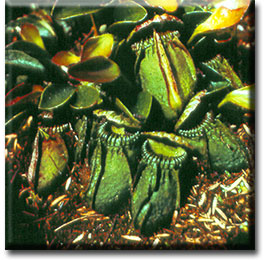 The pitchers of Cephalotus nestle close to each other and are usually found in moss at ground level. The Albany pitcher plant grows in scrubby areas that are moist all year around, on sandy soils that are acid--a habitat rather like that of many other carnivorous plants. The Albany pitcher plant flowers in late summer, after most other plants in the region where it grows have flowered. The flowers of Cephalotus are rarely seen on cultivated plants--in part because it's a difficult plant to cultivate. This old illustration from Curtis's Botanical Magazine shows that the flowers of Cephalotus have size sepals, six petals (rather hooded), six stamens. The six carpels are at the bottom of a bowl-like disk. These features are somewhat like those of saxifrages, and that was long thought to be the family closest to Cephalotaceae. The flowers of Cephalotus are, in fact, somewhat like those of saxifrages. But DNA evidence has now revealed a slightly closer relationship--to Oxalis and its relatives. But it's still clearly in its own family. 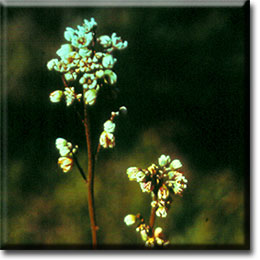 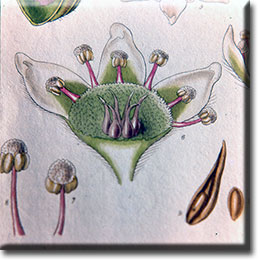 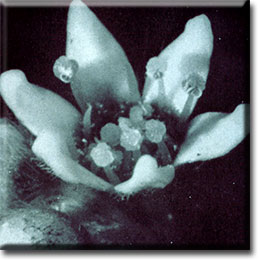 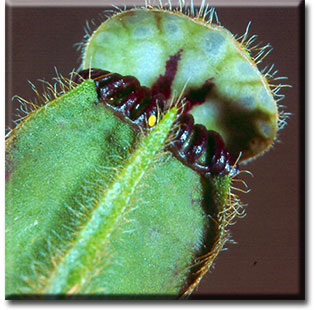 Viewed from the front, pitchers of Cephalotus have three wings, the middle one with a groove in it. The lid of the pitcher and the wings are hairy. Seen from the side, pitchers of Cephalotus show that the lid is only a small distance above the mouth of the pitcher. The mouth of the pitcher is a dark red. A slender portion of the leaf, at right, connects the pitcher to the stem. The mouth of the pitcher is red to purple, a color range that is evidently attractive to insects. Like the mouth of pitchers of the "true" pitcher plant, Nepenthes, the mouth of the Albany pitcher plant has smooth ridges. These point the insect toward the inside of the pitcher. The ridges are smooth, and the insect may lose its footing, slipping into the liquid pool inside the pitcher. 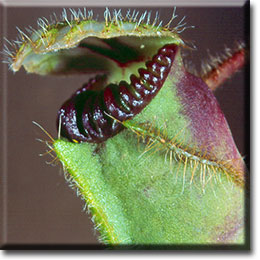 Viewed from the top of the pitcher, the nature of the lid is evident. There are translucent patches in the green tissue. If an insect is inside the pitcher and hasn't yet been caught in the liquid pool, it may fly upward, responding to the light it sees in these "windows" as though it were flying toward the sky... With some light beneath the lid as well as on its surface, the window-like nature of the translucent areas is clearly evident. Interestingly, the same feature can be found in the lids of the unrelated North American pitcher plants Darlingtonia and Sarracenia. To see why the pitcher of Cephalotus is such a good trap, let's look at a section of the pitcher, starting at the top. At the top, we see a piece of the lid. Then, not far below, the reddish-purple mouth. It not only has slippery surfaces, it has some tiny downwardly-pointing teeth arching over the pitcher, so that an insect tends to return to the pitcher rather than escapee from it. And then, below that, there's one more device to keep an insect inside--a second rim. Below that, the purple and whitish surfaces of the pitcher are difficult for an insect to climb. It an insect isn't caught immediately by the pool, it will tend to buzz around in the pitcher, fooled by the "windows" in the lid, and will probably fail to climb out and will tire enough so that eventually it will fall into the liquid pool at the bottom of the pitcher. 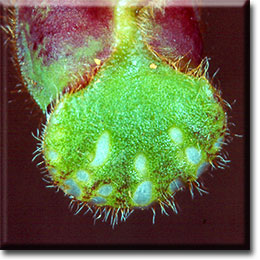 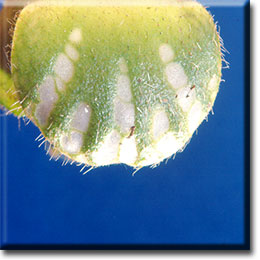 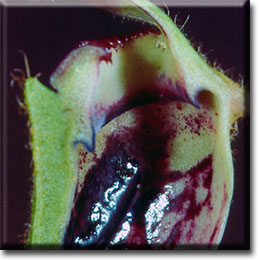 |
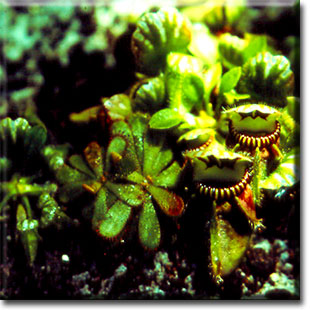 TRAP TYPE: Pitfall Trap
TRAP TYPE: Pitfall Trap



